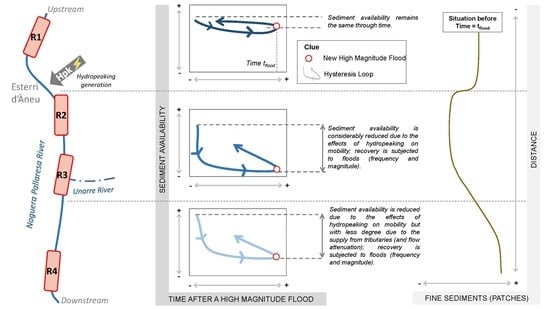Effects of Hydropeaking on Bed Mobility: Evidence from a Pyrenean River
Abstract
1. Introduction
2. Study Area
2.1. The Basin
2.2. The Study Site
3. Methods
3.1. Channel Topography
3.2. Flow Hydraulics and Hydrological Scenarios
3.3. Bed Materials Characterization
3.3.1. Surface Materials
3.3.2. Subsurface Materials
3.4. Bed-Material Mobility
3.4.1. Mobility
3.4.2. Entrainment Conditions
4. Results
4.1. River-Bed Topography and Grain-Size
4.2. Flow Scenarios
4.2.1. Scenario 1
4.2.2. Scenario 2
4.2.3. Scenario 3
4.3. Bed-Material Mobility
4.3.1. Field Observations
Scenario 1
Scenario 2
Scenario 3
4.3.2. Entrainment Thresholds
5. Discussion
5.1. Spatial and Temporal Effects of Hydropeaking on River-Bed Mobility
- (a)
- Size-dependent model in which the displacement of sediments is inverse to their size. This model can be attributed to low magnitude floods and to the entire hydropeaking regime, mainly affecting fine surface sediments (typically from patches) and the finer part of the coarse movable GSD. Flow hydraulics during these conditions are of low magnitude and high frequency and are not competent to entrain and transport the entire spectrum of the surface bed materials (mobile fractions). This model is also conditioned by sediment availability, a fact of great importance in the hydropeaked reaches where the frequency of these flows is daily and the entrainment of bed materials is not balanced by the supply of sediment from upstream. Under these conditions the river-bed becomes depleted of fine sediments from patches (e.g., [14]) and progressively lacks other fractions such as medium gravels, all of which are highly relevant from an ecological point of view. These reaches can be classed as supply-limited, as their incipient sedimentary recovery can be observed downstream from tributaries (as the Unarre in our study case) that periodically supplies fresh new sediments to the mainstem Noguera Pallaresa, and also due to the loss of competence of hydropeaks as they are routed downstream.
- (b)
- ‘Hydraulic-dependent mobility model’ in which the displacement of particles is not conditioned by their size, but depends on the magnitude and duration of a given competent flow. This model is generally linked to high magnitude floods that exhibit the capacity to mobilize most of the mobile sediments in the channel, i.e., all except the structural elements. The frequency of these flows is relatively low but they determine the supply of sediment to both the control and impacted reaches. High competence may cause the break-up of the armour layer (see for instance examples in dammed rivers e.g., [12]), supplying fine subsurface sediments and, together with the overall sediment supply from upstream, increasing their availability along the river channel. The frequency of these flows also influences the mobility observed during hydropeaking, a fact that is again related to the availability of sediment in the river bed (Figure 13).
5.2. Bed Mobility and Habitat
6. Conclusions
Author Contributions
Funding
Acknowledgments
Conflicts of Interest
References
- Yang, S.L.; Zhang, J.; Xu, X.R. Influence of the Three Gorges Dam on downstream delivery of sediment and its environmental implications, Yangtze River. Geophys. Res. Lett. 2007, 34, L10401. [Google Scholar] [CrossRef]
- De Vincenzo, A.; Molino, A.J.; Molino, B.; Scorpio, V. Reservoir rehabilitation: The new methodological approach of Economic Environmental Defence. Int. J. Sediment Res. 2017, 32, 288–294. [Google Scholar] [CrossRef]
- Kondolf, G.M. Hungry water: Effects of dams and gravel mining on river channel. Environ. Manag. 1997, 21, 533–551. [Google Scholar] [CrossRef]
- Vericat, D.; Batalla, R.J. Sediment transport in a large impounded river: The lower Ebro, NE Iberian Peninsula. Geomorphology 2006, 79, 72–92. [Google Scholar] [CrossRef]
- Church, M. Bed Material Transport and the Morphology of Alluvial River Channels. Annu. Rev. Earth Planet. Sci. 2006, 34, 325–354. [Google Scholar] [CrossRef]
- Batalla, R.J.; Vericat, D. Hydrological and sediment transport dynamics of flushing flows: Implications for river management in large Mediterranean Rivers. River Res. Appl. 2009, 25, 297–314. [Google Scholar] [CrossRef]
- Rempel, L.L.; Church, M. Physical and ecological response to disturbance by gravel mining in a large alluvial river. Can. J. Fish. Aquat. Sci. 2009, 66, 52–71. [Google Scholar] [CrossRef]
- Llena, M.; Vericat, D.; Martínez-Casasnovas, J.A.; Smith, M. Geormorphic responses to multi-scale disturbances in a mountain river: A century of observations. Catena 2019. accepted. [Google Scholar]
- Gostner, W.; Lucarelli, C.; Theiner, D.; Kager, A.; Premstaller, G.; Schleiss, A.J. A holistic aooriach to reduce negative inpavcts of Hydropeaking. In Dams and Reservoirs under Changing Challenges; Boes, R.M., Scheiss, A.J., Eds.; Taylor & Francis Group: Abingdon, UK, 2011; pp. 857–865. [Google Scholar]
- Parker, G.; Klingeman, P.C. On why gravel bed streams are paved. Water Resour. Res. 1982, 18, 1409–1423. [Google Scholar] [CrossRef]
- Wilcock, P.R.; DeTempe, D.T. Persistence of armor layers in gravel-bed streams. Geophys. Res. Lett. 2005, 32, L08402. [Google Scholar] [CrossRef]
- Vericat, D.; Batalla, R.J.; Garcia, C. Breakup and reestablishment of the armour layer in a highly regulated large gravel-bed river: The lower Ebro. Geomorphology 2006, 76, 122–136. [Google Scholar] [CrossRef]
- White, R.W.; Day, T.J. Transport of graded gravel bed material. In Gravel-Bed Rivers; Hey, J.C., Bathurst, J.C., Thorne, C.R., Eds.; John Wiley: Hoboken, NJ, USA, 1982; pp. 181–223. [Google Scholar]
- Vericat, D.; Batalla, R.J.; Gibbins, C.N. Sediment entrainment and depletion from patches of fine material in a gravel-bed river. Water Resour. Res. 2008, 44, W11415. [Google Scholar] [CrossRef]
- Batalla, R.J.; Vericat, D.; Gibbins, C.N.; Garcia, C. Incipient Bed-Material Motion in a Gravel-Bed River: Field Observations and Measurements. In Bedload-Surrogate Monitoring Technologies; Gray, J.R., Laronne, J.B., Marr, J.D.G., Eds.; U.S. Department of the Interior and U.S. Geological Survey: Reston, VA, USA, 2010; pp. 52–66. [Google Scholar]
- Garcia, C.; Laronne, J.B.; Sala, M. Variable source areas of bedload in a gravel-bed stream. J. Sediment. Res. 1999, 69, 27–31. [Google Scholar] [CrossRef]
- Gibbins, C.; Vericat, D.; Batalla, R.J. When is stream invertebrate drift catastrophic? The role of hydraulics and sediment transport in initiating drift during flood events. Freshw. Biol. 2007, 52, 2369–2384. [Google Scholar] [CrossRef]
- Cushman, R.M. Review of ecological effects of rapidly varying flows downstream of hydroelectric facilities. N. Am. J. Fish. Manag. 1985, 5, 330–339. [Google Scholar] [CrossRef]
- Heggenes, J.; Omholt, O.K.; Kristiansen, J.R.; Sageie, J.; Okland, F.; Dokk, J.G.; Beere, M.C. Movements by wild brown trout in a boreal river: Response to habitat and flow contrasts. Fish. Manag. Ecol. 2007, 14, 333–342. [Google Scholar] [CrossRef]
- Lauters, F.; Lavandier, P.; Lim, P.; Sabaton, C.; Belaud, A. Influence of hydropeaking on invertebrates and their relationship with fish feeding habits in a Pyrenean river. Regul. Rivers Res. Manag. 1996, 12, 563–573. [Google Scholar] [CrossRef]
- Liebig, H.; Cereghino, R.; Lim, P.; Belaud, A.; Lek, S. Impact of hydropeaking on the abundance of juvenile brown trout in a Pyrenean stream. Arch. Für Hydrobiol. 1999, 144, 439–454. [Google Scholar] [CrossRef]
- Lagarrigue, T.; Céréghino, R.; Lim, P.; Reyes-Marchant, P.; Chappaz, R.; Lavandier, P.; Belaud, A. Diel and seasonal variations in brown trout (Salmo trutta) feeding patterns and relationship with invertebrate drift under natural and hydropeaking conditions in a mountain stream. Aquat. Living Resour. 2002, 15, 129–137. [Google Scholar] [CrossRef]
- Cereghino, R.; Cugny, P.; Lavandier, P. Influence of intermittent hydropeaking on the longitudinal zonation patterns of benthic invertebrates in a mountain stream. Int. Rev. Hydrobiol. 2002, 87, 47–60. [Google Scholar] [CrossRef]
- Frutiger, A. Ecological impacts of hydroelectric power production on the River Ticino. Part 1: Thermal effects. Arch. Für Hydrobiol. 2004, 159, 43–56. [Google Scholar] [CrossRef]
- Bruno, M.C.; Maiolini, B.; Carolli, M.; Silveri, L. Impact of hydropeaking on hyporheic invertebrates in an Alpine stream (Trentino, Italy). Ann. Limnol. Int. J. Limnol. 2009, 45, 157–170. [Google Scholar] [CrossRef]
- Schmutz, S.; Bakken, T.H.; Friedrich, T.; Greimel, F.; Harby, A.; Jungwirth, M.; Melcher, A.; Unfer, G.; Zeiringer, B. Response of fish communities to hydrological and morphological alterations in hydropeaking rivers of Austria. River Res. Appl. 2014, 31, 919–930. [Google Scholar] [CrossRef]
- Casas-Mulet, R.; Alfredsen, K.; Hamududu, B.; Prasad Timalsina, N. The effects of hydropeaking on hyporheic interactions based on field experiments. Hydrol. Process. 2014, 29, 1370–1384. [Google Scholar] [CrossRef]
- Buendia, C.; Sabater, S.; Palau, A.; Batalla, R.J.; Marcé, R. Using equilibrium temperature to assess thermal disturbances in rivers. Hydrol. Process. 2015, 29, 4350–4360. [Google Scholar] [CrossRef]
- Herrero, A.; Buendía, C.; Bussi, G.; Sabater, S.; Vericat, D.; Palau, A.; Batalla, R.J. Modelling the hydrosedimentary response of a large pyrennean catchment to global change. J. Soils Sediments 2017, 17, 2677–2690. [Google Scholar] [CrossRef]
- Wolman, M.G. A method of sampling coarse bed material. Am. Geophys. Union Trans. 1954, 35, 951–956. [Google Scholar] [CrossRef]
- Rice, S.; Church, M. Sampling surficial fluvial gravels: The precision of size distribution percentile estimates. J. Sediment. Res. 1996, 66, 654–665. [Google Scholar] [CrossRef]
- Lisle, T.E.; Madej, M.A. Spatial variation in a channel with high sediment supply. In Dynamics of Gravel Bed Rivers; Billi, P., Hey, R.D., Thorne, C.R., Tacconi, P., Eds.; John Willey: Hoboken, NJ, USA, 1992; pp. 277–291. [Google Scholar]
- Church, M.; McLean, D.G.; Wolcott, J.F. River bed gravels: Sampling and analysis. In Sediment Transport in Gravel-Bed Rivers; Thorne, C.R., Barthurst, J.C., Hey, R.D., Eds.; John Wiley and Sons: Hoboken, NJ, USA, 1987; pp. 43–88. [Google Scholar]
- Bunte, K.; Abt, S.R. Sampling Surface and Subsurface. Particle-Size Distributions in Wadable Gravel- and Cobble-Bed Streams for Analyses in Sediment Transport, Hydraulics, and Streambed Monitoring; U.S. Department of Agriculture, Forest Services, Rocky Mountain Research Station: Fort Collins, CO, USA, 2001; p. 428.
- Spieker, R.; Ergenzinger, P. New developments in measuring bedload by magnetic tracer technique. In Erosion, Transport, and Deposition Processes; Walling, D.E., Yair, A., Berkowicz, S., Eds.; IAHS Publication: Wallingford, UK, 1990; pp. 169–178. [Google Scholar]
- Church, M.; Hassan, M.A. Mobility of bed material in Harris Creek. Water Resour. Res. 2002, 38, 1237. [Google Scholar] [CrossRef]
- Vericat, D.; Batalla, R.J.; Garcia, C. Bed-material mobility in a large river below dams. Geodin. Acta 2008, 21, 3–10. [Google Scholar] [CrossRef][Green Version]
- Liébault, F.; Bellot, H.; Chapuis, M.; Klotz, S.; Deschâtres, M. Bedload tracing in a high-sediment-load mountain stream. Earth Surf. Process. Landf. 2012, 37, 385–399. [Google Scholar] [CrossRef]
- Folk, R.L.; Ward, C. Brazos River bar: A study in the significance of grain size parameters. J. Sediment. Petrol. 1957, 27, 3–26. [Google Scholar] [CrossRef]
- Petit, F.; Gob, F.; Houbrechts, G.; Assani, A.A. Critical specific stream power in gravel-bed rivers. Geomorpholohy 2005, 69, 92–101. [Google Scholar] [CrossRef]
- Garcia, C.; Cohen, H.; Reid, I.; Rovira, A.; Úbeda, X.; Laronne, J.B. Processes of initiation of motion leading to bedload transport in gravel-bed rivers. Geophys. Res. Lett. 2007, 34, L06403. [Google Scholar] [CrossRef]
- Egiazaroff, I.A. Calculation of non-uniform sediment concentrations. J. Hydraul. Div. Am. Soc. Civ. Eng. 1965, 91, 225–247. [Google Scholar]
- Gordon, N.D.; McMahon, T.A.; Finlayson, B.L. Stream Hydrology: An introduction for Ecologists; John Wiley and Sons: Hoboken, NJ, USA, 1992; p. 448. [Google Scholar]
- Gore, J.A. Discharge measurements and streamflow analysis. In Methods in Stream Ecology; Hauer, F.R., Lamberti, G.A., Eds.; Academic Press: Cambridge, MA, USA, 1996; pp. 53–74. [Google Scholar]
- Schwendel, A.C.; Death, R.G.; Fuller, I.C. The assessment of shear stress and bed stability in stream ecology. Freshw. Biol. 2010, 55, 261–281. [Google Scholar] [CrossRef]
- Carson, M.A.; Grifiiths, G. Bedload transport in gravel channels. J. Hydrol. 1987, 26, 1–151. [Google Scholar]
- Sutherland, A.J. Hiding Function to Predict Self Armoring, Mitt. 117; Inst. of Hydraul., Hydrol. and Glaciol., Eidg. Tech. Hochsch.: Zürich, Switzerland, 1992. [Google Scholar]
- Marteau, B.; Batalla, R.J.; Vericat, D.; Gibbins, C. Asynchronicity of fine sediment supply and its effects on transport and storage in a regulated river. J. Soils Sediments 2018, 18, 2614–2633. [Google Scholar] [CrossRef]
- Kondolf, M.G.; Wolman, M.G. The sieze of Salmonid Spawining Gravels. Water Resour. Res. 1993, 29, 2275–2285. [Google Scholar] [CrossRef]
- Ceola, S.; Hödl, I.; Adlboller, M.; Singer, G.; Bertuzzo, E.; Mari, L.; Botter, G.; Waringer, J.; Battin, T.J.; Rinaldo, A. Hydrologic Variability Affects Invertebrate Grazing on Phototrophic Biofilms in Stream Microcosms. PLoS ONE 2013, 8, e60629. [Google Scholar] [CrossRef]
- Jowett, I.G. Hydraulic constraints on habitat suitability for benthic invertebrates in gravel-bed rivers. River Res. Appl. 2003, 19, 495–507. [Google Scholar] [CrossRef]
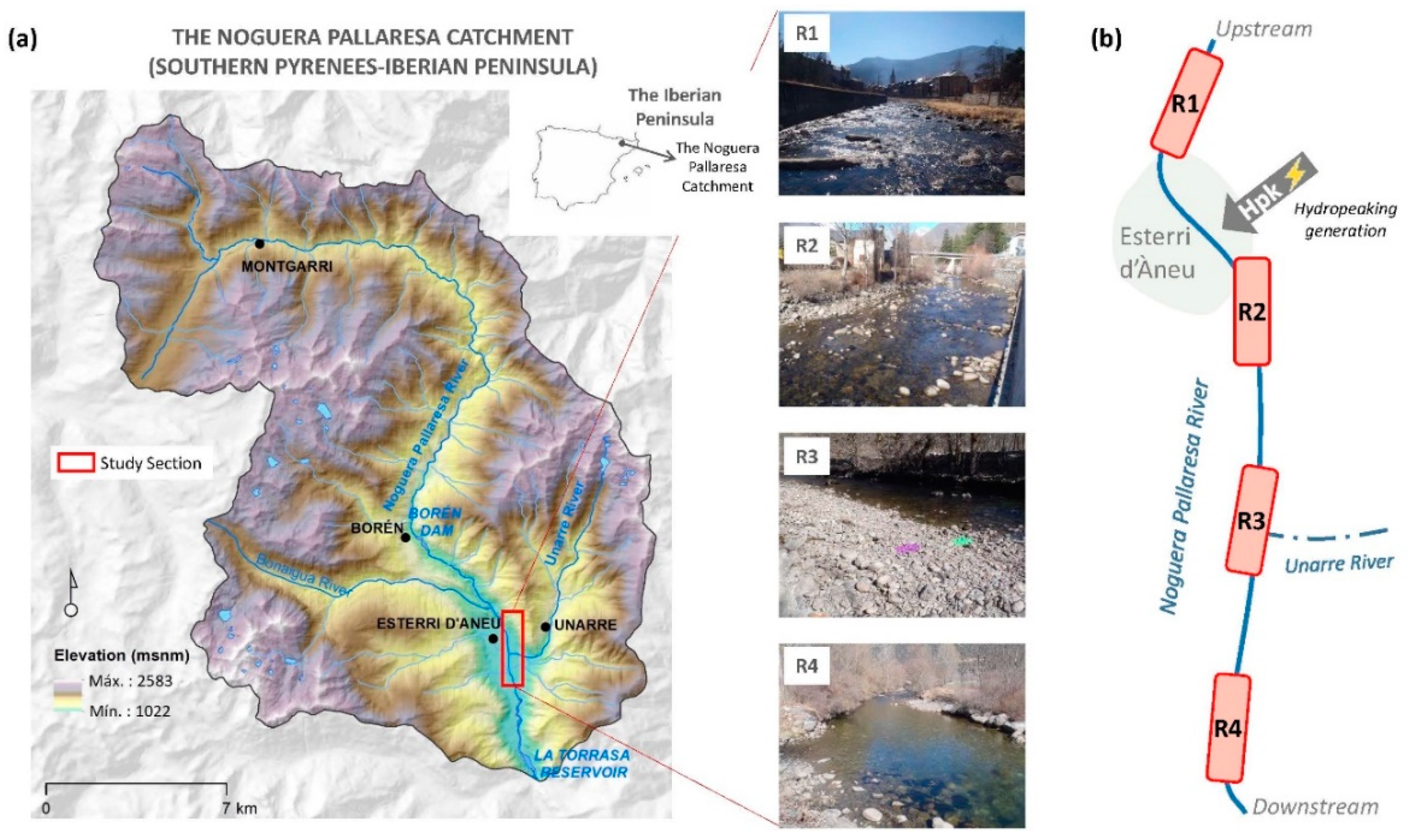


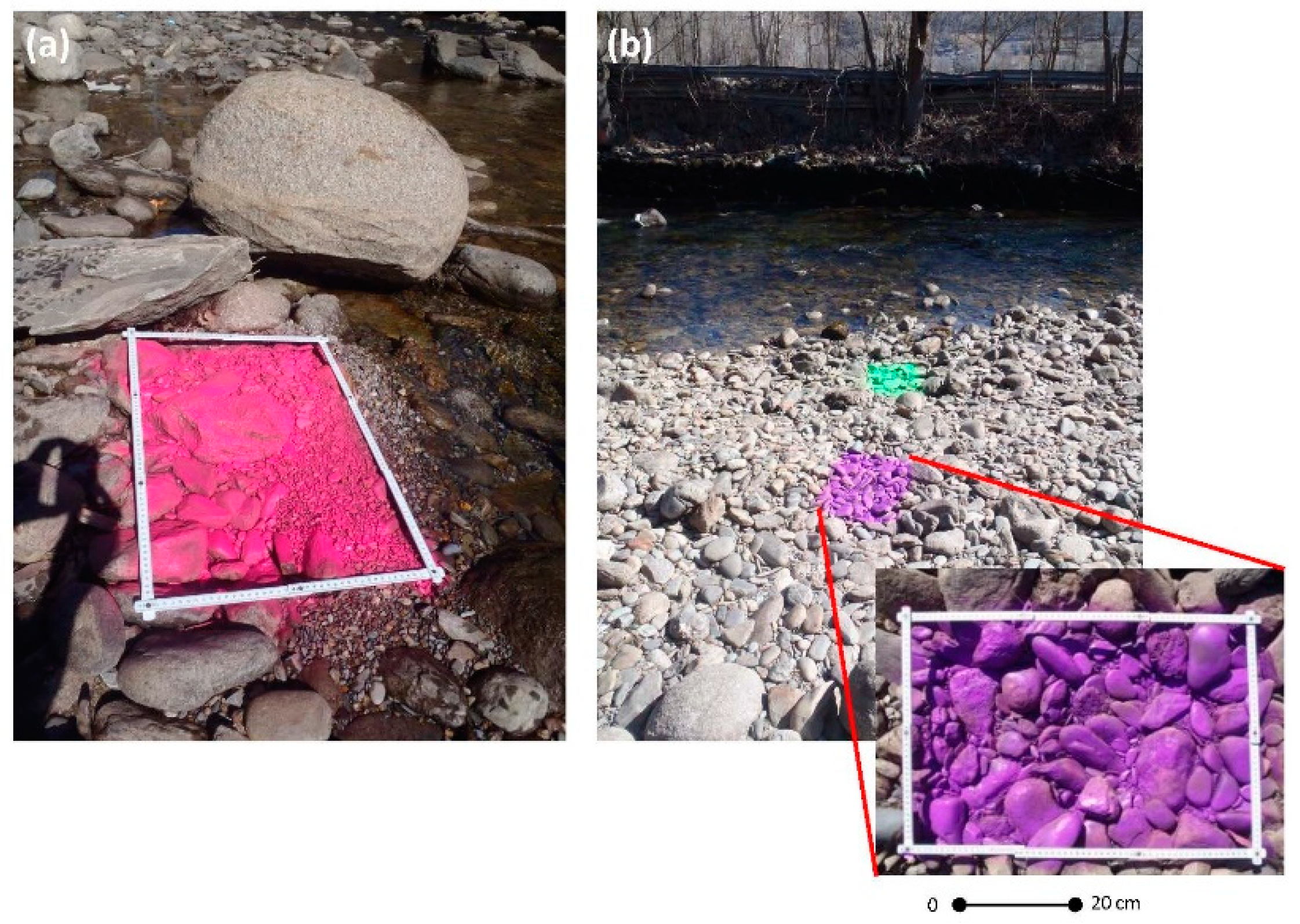
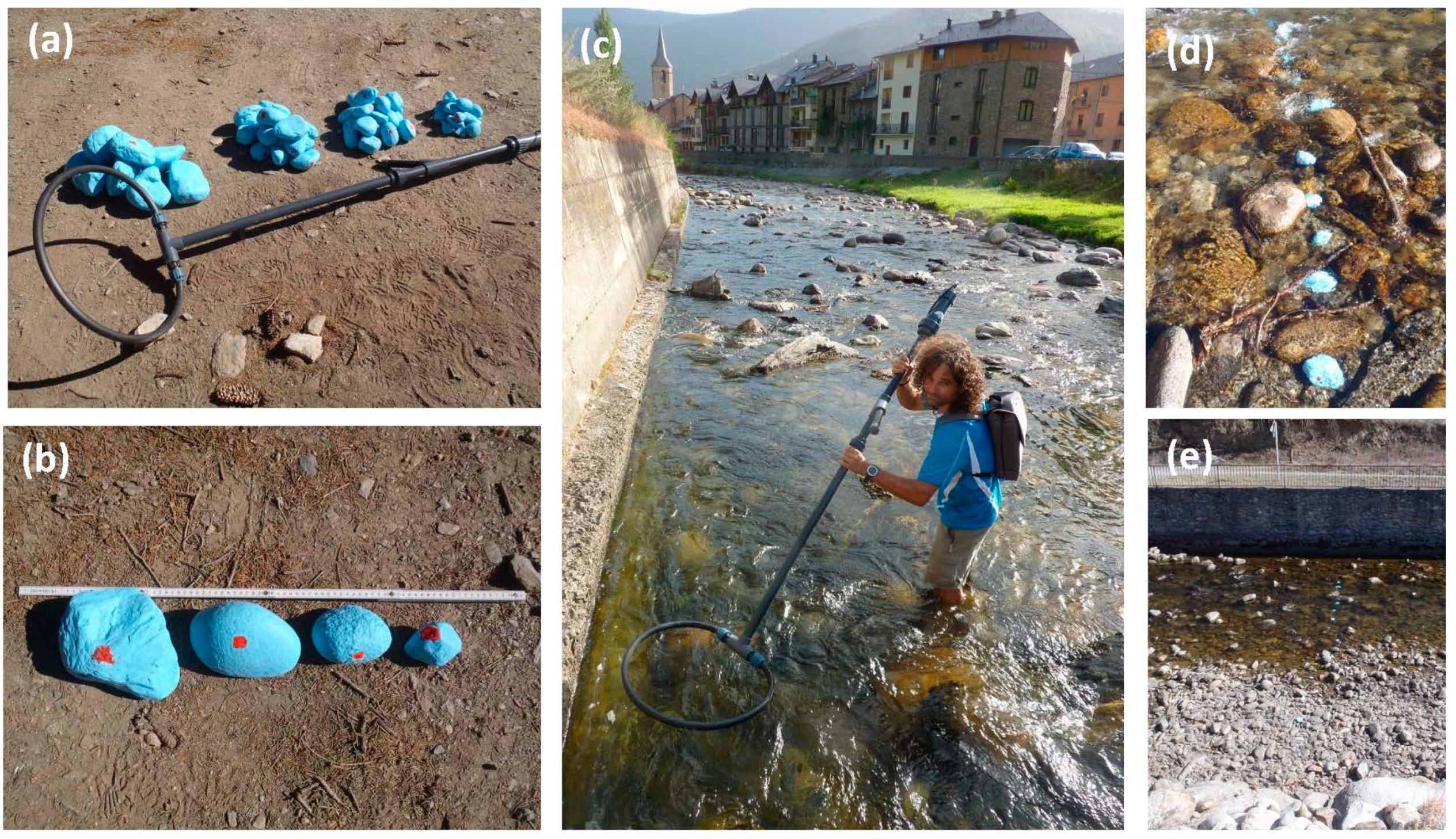
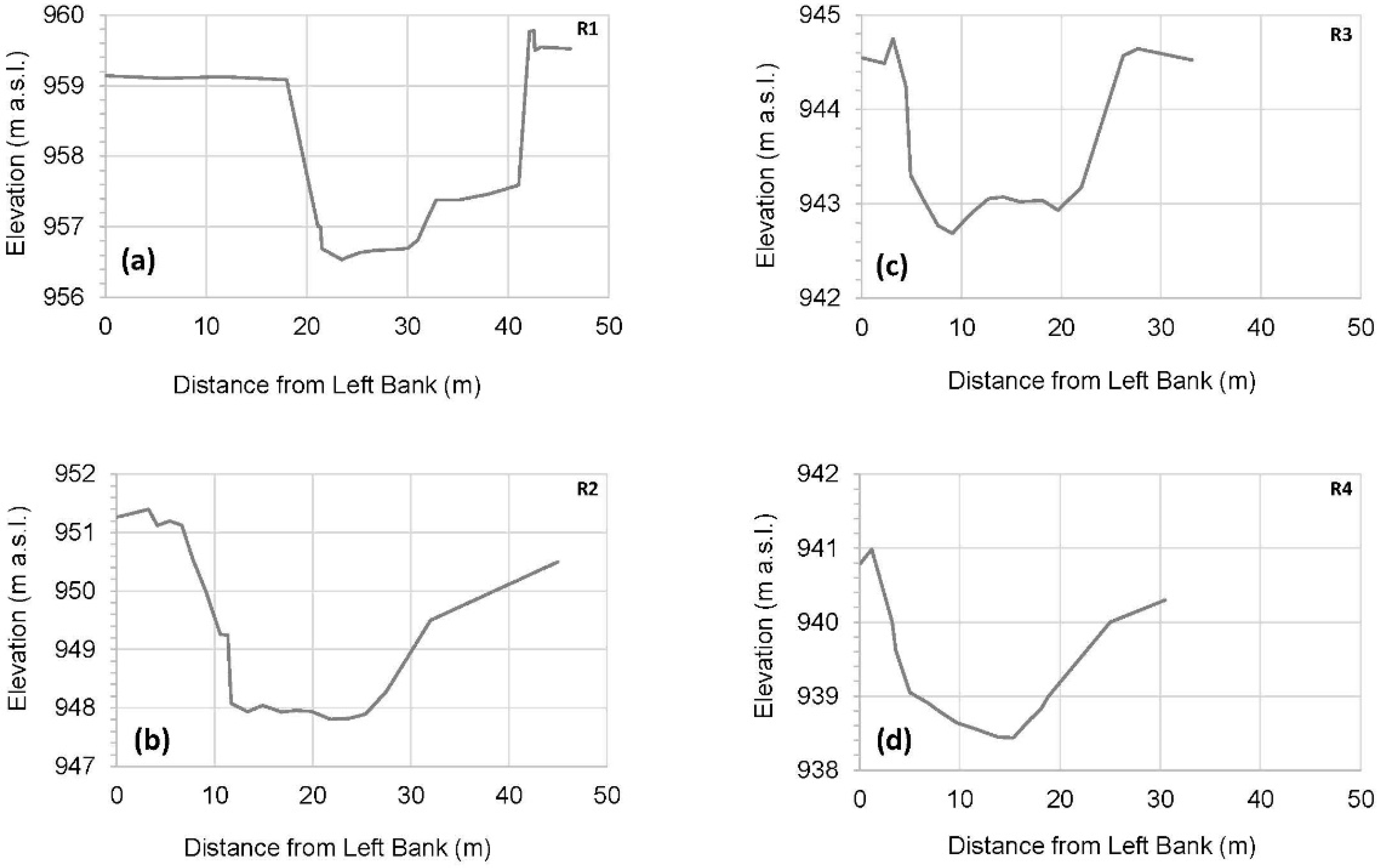
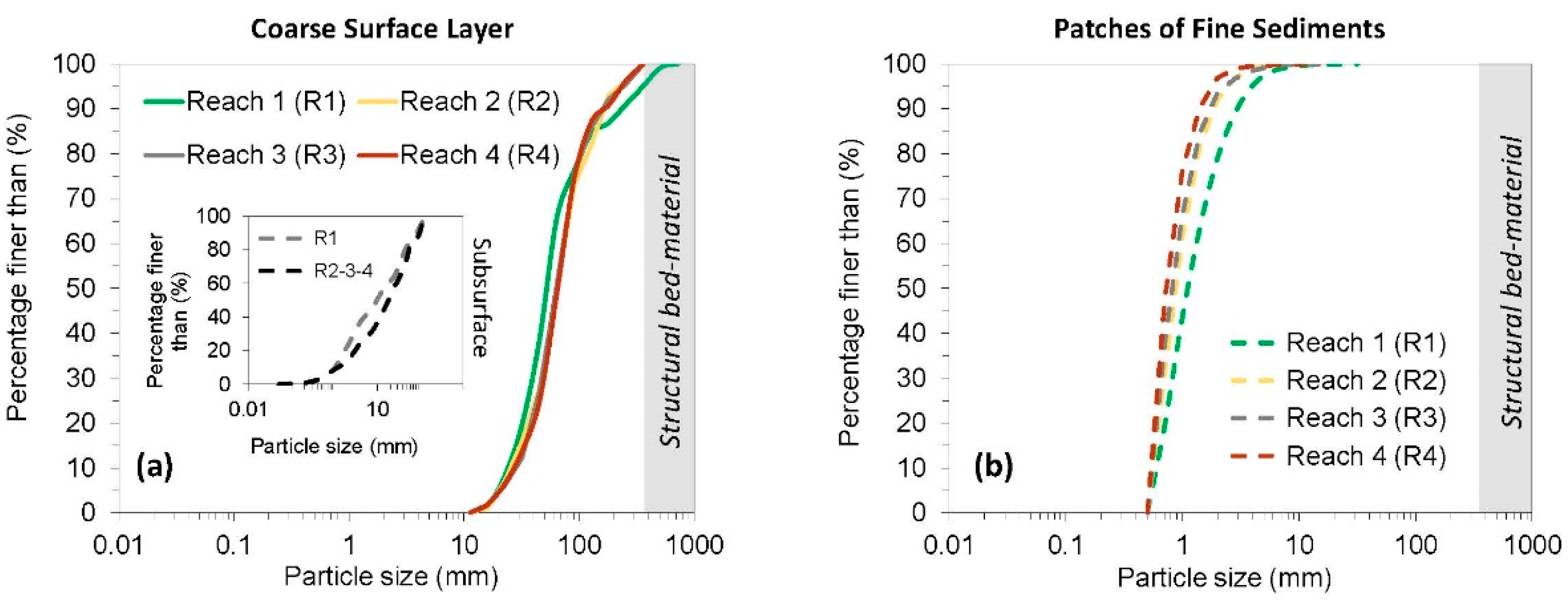
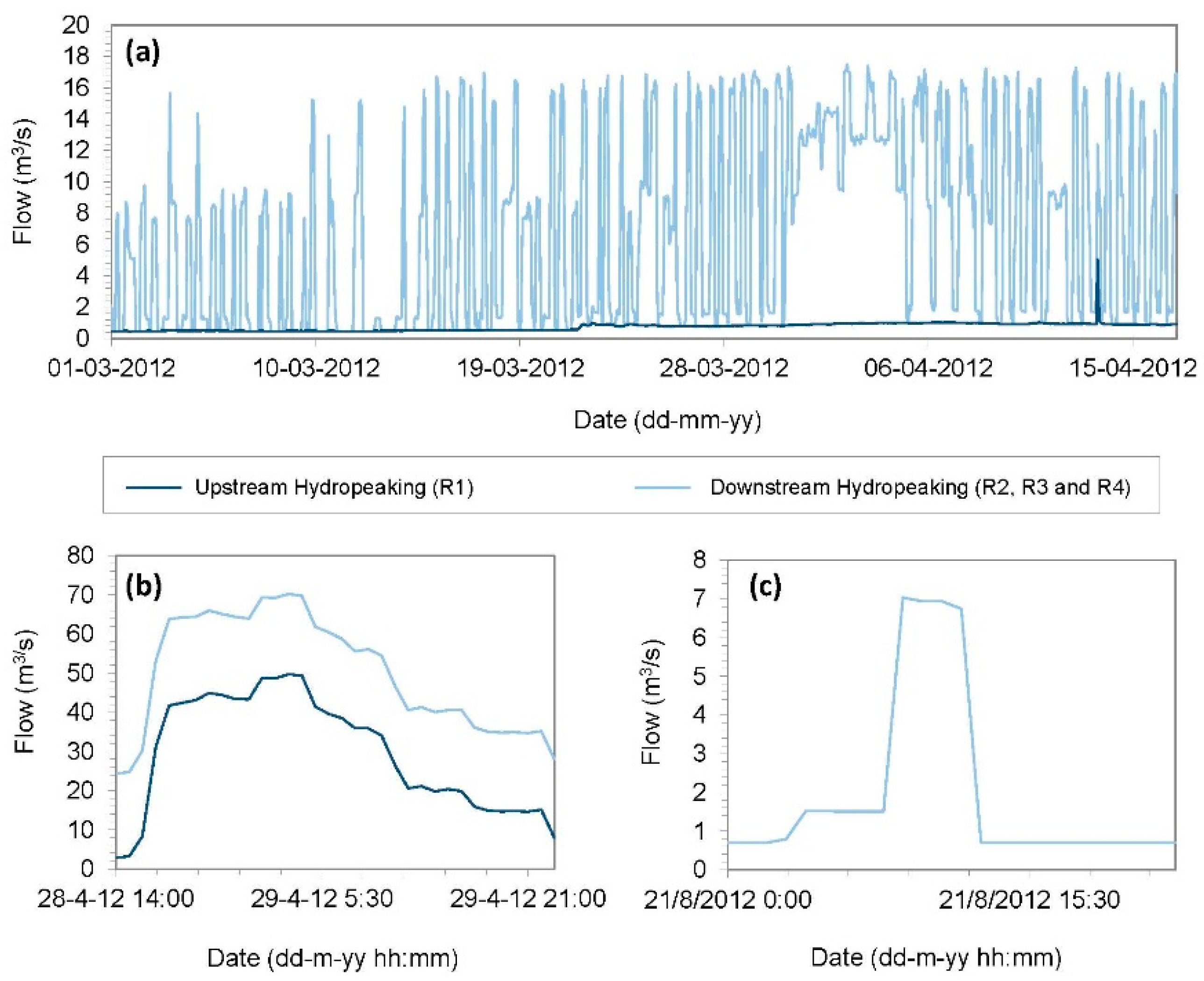
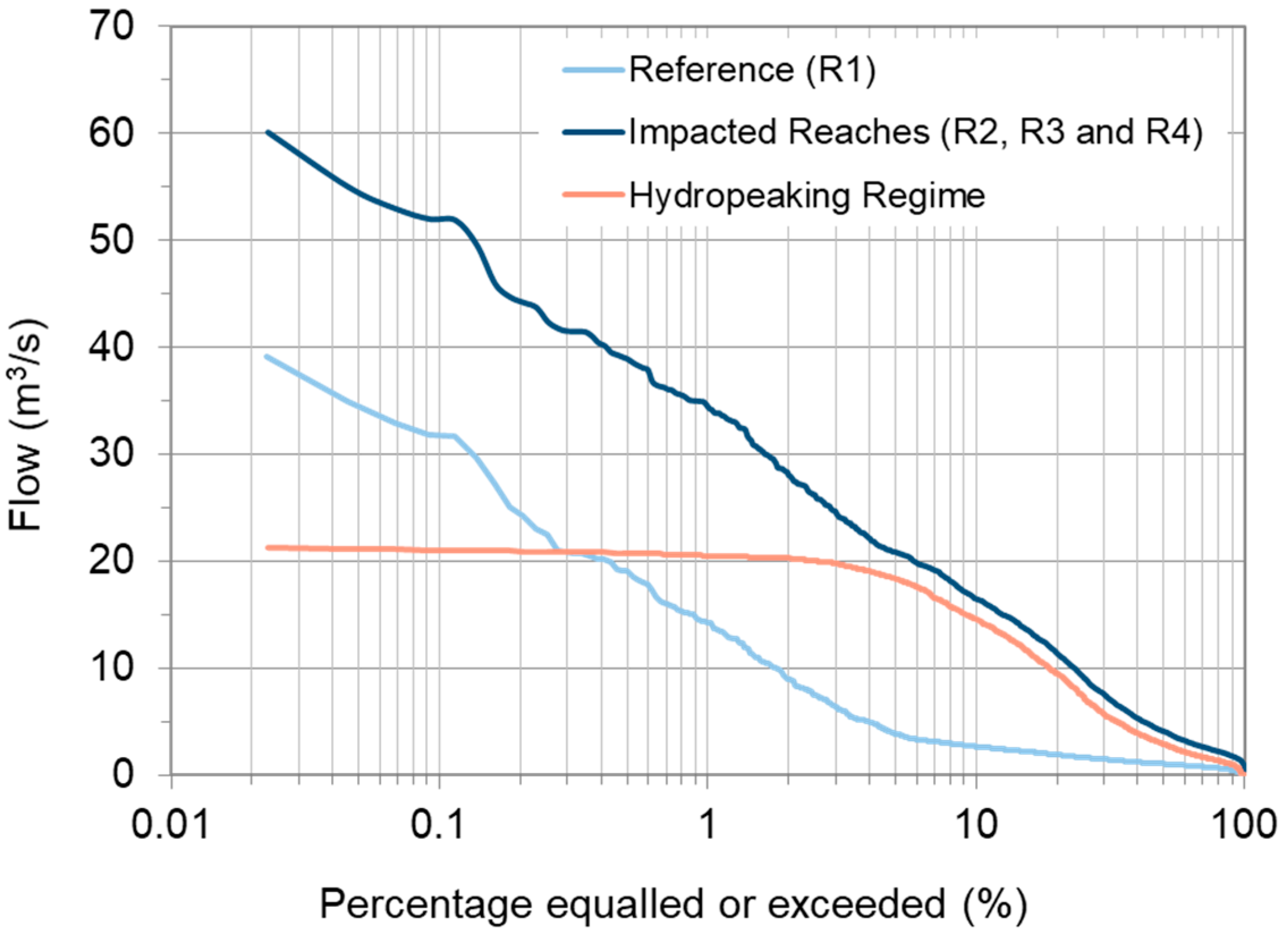
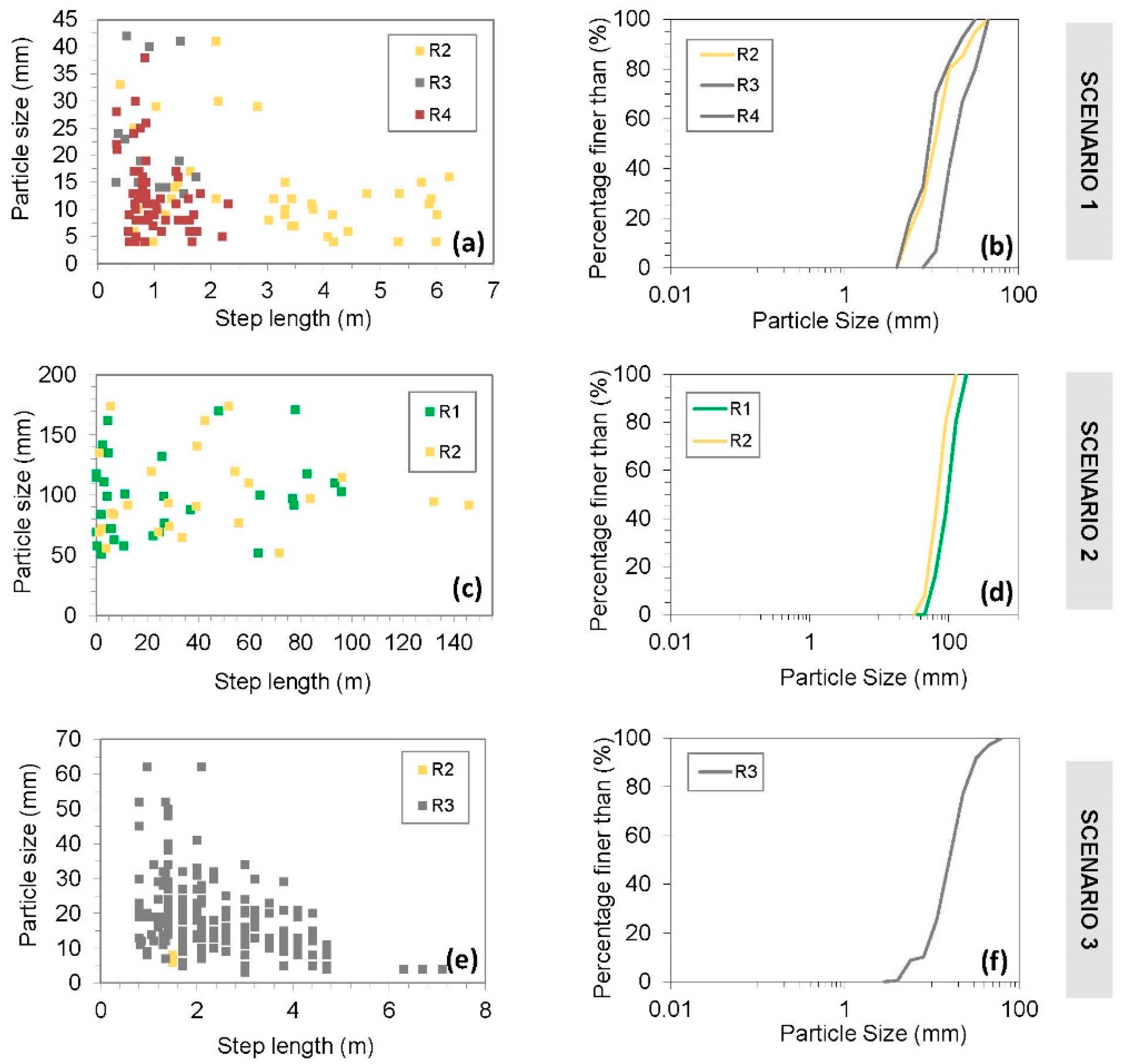
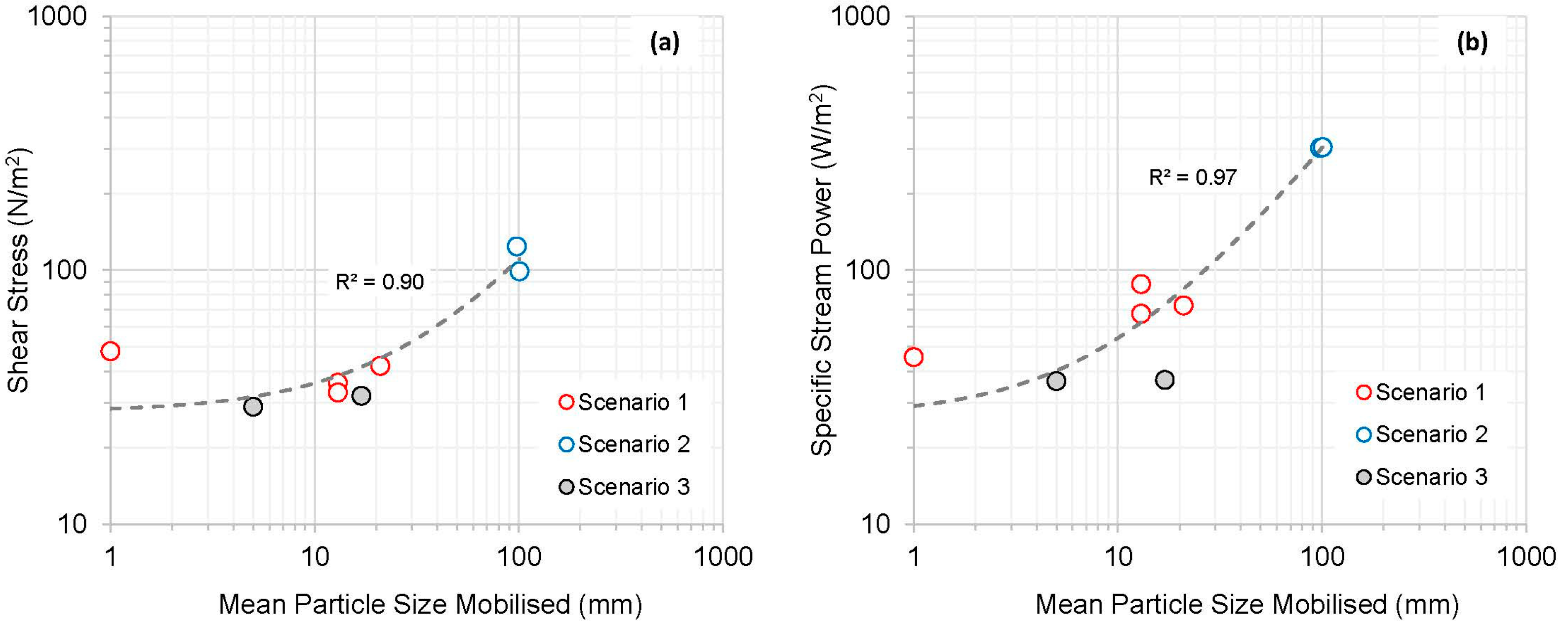
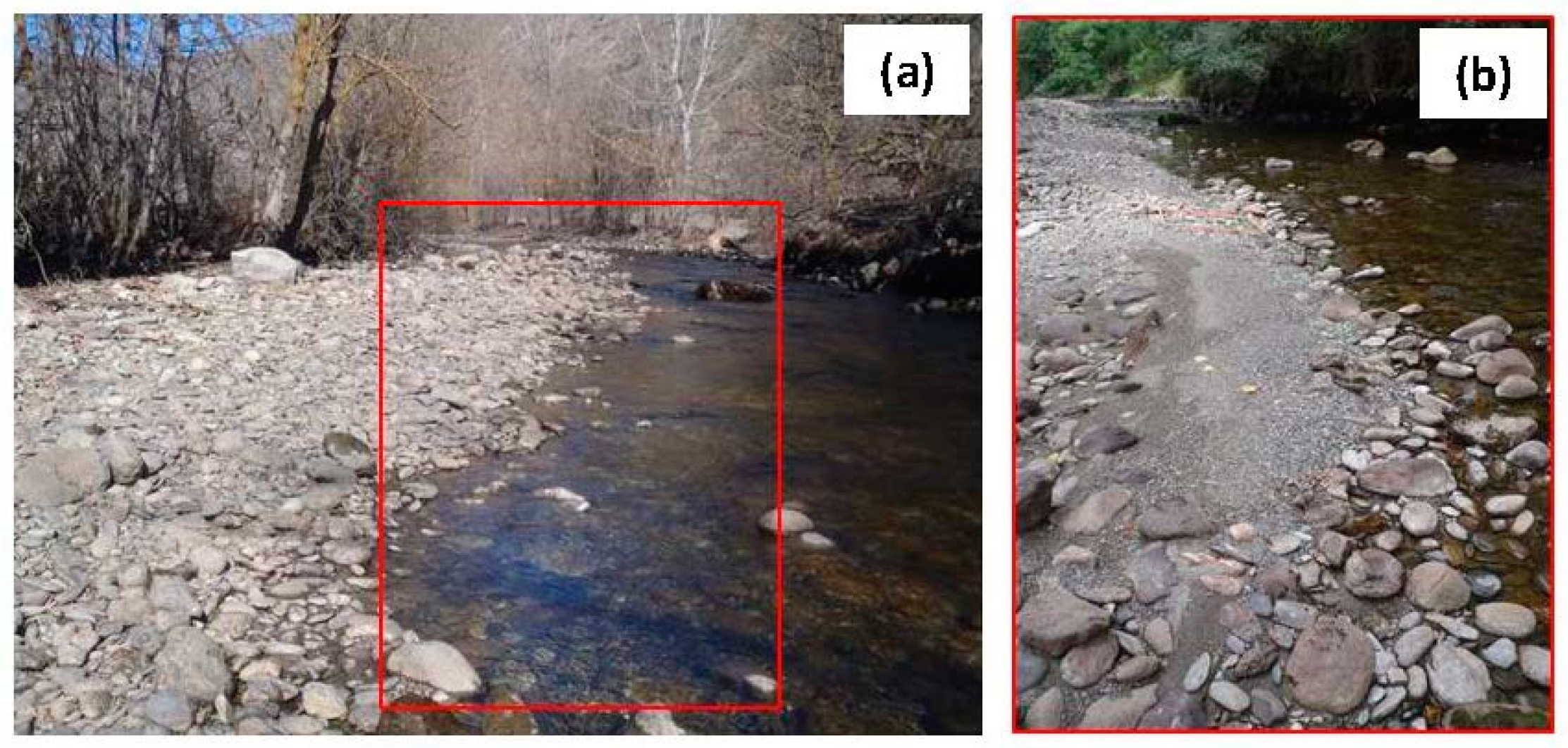
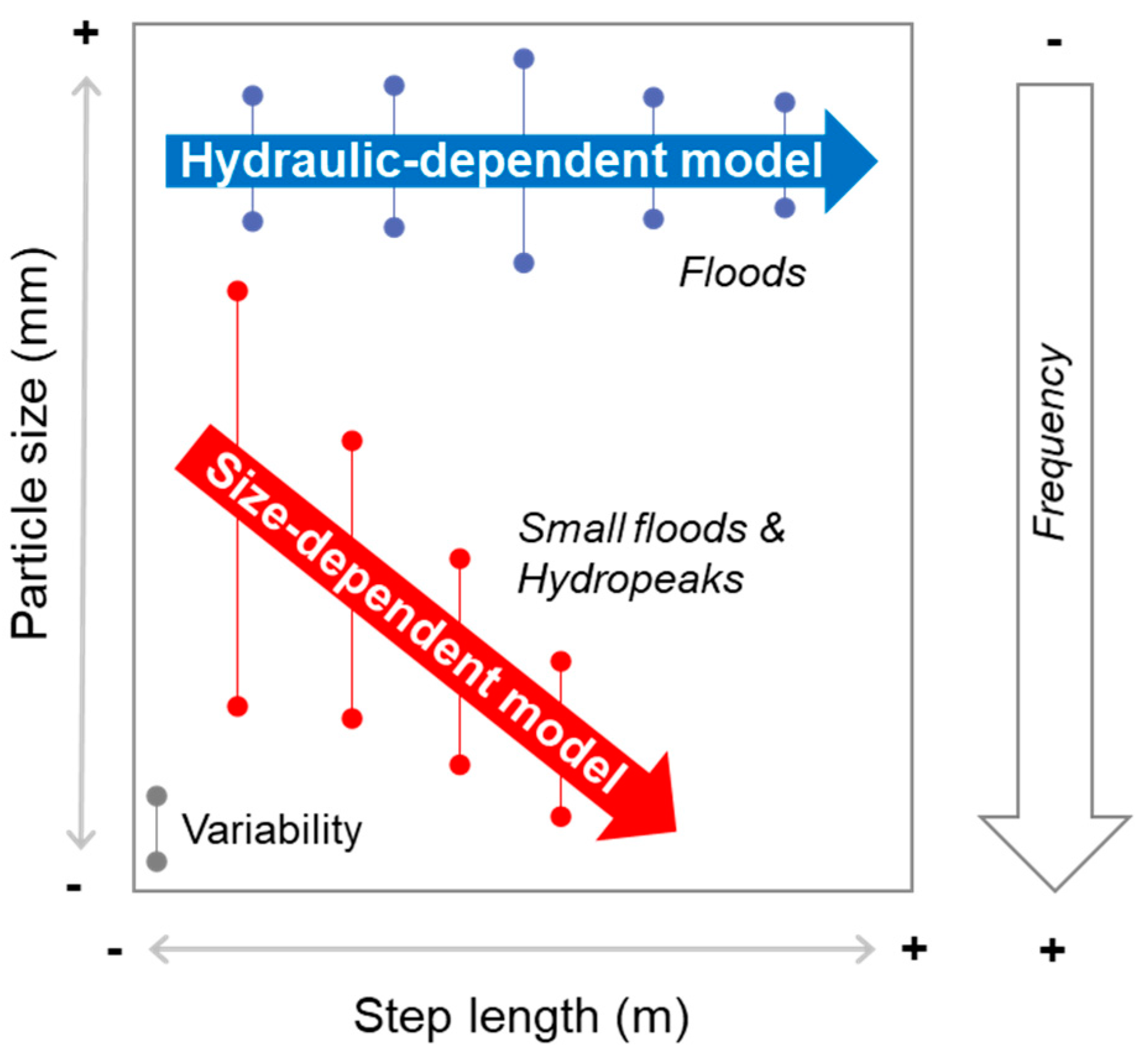
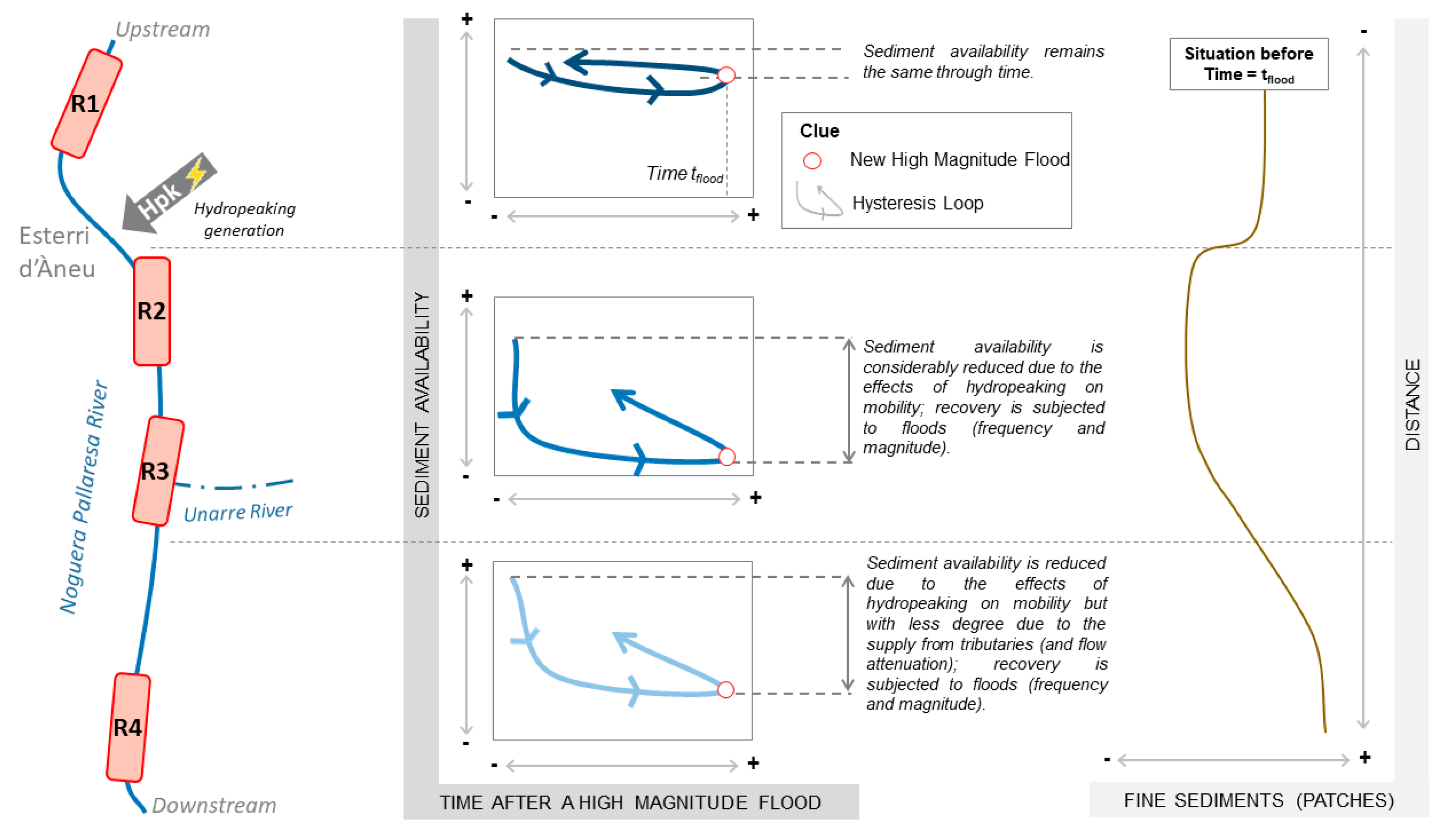
| Characteristic Grain-Size Values | Surface Sediments Configurations | Subsurface Sediments | ||||||||||||||
|---|---|---|---|---|---|---|---|---|---|---|---|---|---|---|---|---|
| Structural Bed-Material | Coarse Surface Layer (Movable) | Patches of Fine Sediments | ||||||||||||||
| R1 | R2 | R3 | R4 | R1 | R2 | R3 | R4 | R1 | R2 | R3 | R4 | R1 | R2 | R3 | R4 | |
| Proportion (%) | 15 | 10 | 5 | 4 | 67 | 78 | 77 | 74 | 18 | 12 | 18 | 22 | - | - | - | - |
| Percentile 16 (D16) | - | - | - | - | 29 | 32 | 35 | 34 | 0.66 | 0.60 | 0.58 | 0.56 | 1.4 | - | 2.3 | - |
| Percentile 50 (D50) | 881 | 717 | 442 | 373 | 52 | 64 | 63 | 65 | 1.12 | 0.88 | 0.82 | 0.73 | 9.7 | - | 18 | - |
| Percentile 84 (D84) | - | - | - | - | 126 | 136 | 120 | 117 | 2.37 | 1.53 | 1.40 | 1.21 | 58 | - | 62 | - |
| Sorting (σF&W) | - | - | - | - | 1.18 | 1.05 | 0.98 | 0.98 | 0.89 | 0.68 | 0.65 | 0.55 | 2.5 | - | 2.3 | - |
| Armouring (Ar) | - | - | - | - | 5.4 | 3.5 | 3.5 | 3.6 | - | - | - | - | - | - | - | - |
| Reach | Scenario 1 Small Magnitude Flood and Hydropeaking | Scenario 2 High Magnitude Flood and Hydropeaking | Scenario 3 A Single Hydropeak | ||||||||||||
|---|---|---|---|---|---|---|---|---|---|---|---|---|---|---|---|
| Flow (m3/s) | Particle Size Mobilised Coarse Surface Layer (mm) | Step Length (m) | Flow (m3/s) | Particle Size Mobilised Coarse Surface Layer (mm) | Step Length (m) | Flow (m3/s) | Particle Size Mobilised Coarse Surface Layer (mm) | Step Length (m) | |||||||
| Largest | Mean | Longest | Mean | Largest | Mean | Longest | Mean | Largest | Mean | Longest | Mean | ||||
| R1 | 5 | 31 | 1 | - | - | 50 | 171 | 98 | 96 | 29 | - | - | - | - | - |
| R2 | 18 | 41 | 13 | 6.0 | 3.0 | 70 | 146 | 101 | 146 | 42 | 7 | 7 | 5 | 1.5 | 1.4 |
| R3 | 18 | 42 | 21 | 1.8 | 0.9 | 70 | - | - | - | - | 7 | 62 | 17 | 7.1 | 2.6 |
| R4 | 18 | 38 | 13 | 2.3 | 0.9 | 70 | - | - | - | - | 7 | - | - | - | - |
| Reach | Entrainment Thresholds | ||||||||
|---|---|---|---|---|---|---|---|---|---|
| Observed Values | |||||||||
| Scenario 1 | Scenario 2 | Scenario 3 | |||||||
| Largest Particle (mm) | Shear Stress (N/m2) | Specific Stream Power (W/m2) | Largest Particle (mm) | Shear Stress (N/m2) | Specific Stream Power (W/m2) | Largest Particle (mm) | Shear Stress (N/m2) | Specific Stream Power (W/m2) | |
| R1 | 31 | 48 | 46 | 171 | 124 | 303 | - | - | - |
| R2 | 41 | 36 | 88 | 174 | 99 | 305 | 7 | 29 | 37 |
| R3 | 42 | 42 | 73 | - | - | - | 62 | 32 | 37 |
| R4 | 38 | 33 | 67 | - | - | - | - | - | - |
| Reach | Entrainment Thresholds | |||||||||
|---|---|---|---|---|---|---|---|---|---|---|
| Predicted Values of Critical Shear Stress | ||||||||||
| Percentile 16 (D16) | Percentile 50 (D50) | Percentile 84 (D84) | Largest Particle Mobilised (Predicted vs. Observed) | |||||||
| Size (mm) | Shear Stress (N/m2) | Size (mm) | Shear Stress (N/m2) | Size (mm) | Shear Stress (N/m2) | Size (mm) | Predicted Shear Stress (N/m2) | Observed Shear Stress (N/m2) | Residual (Observed—Predicted) | |
| R1 | 29 | 21 | 52 | 38 | 126 | 91 | 171 | 124 | 124 | 0 |
| R2 | 32 | 23 | 64 | 47 | 136 | 99 | 174 | 127 | 99 | −28 |
| R3 | 35 | 25 | 63 | 46 | 120 | 87 | 62 | 45 | 32 | −13 |
| R4 | 34 | 25 | 65 | 47 | 117 | 86 | 38 | 28 | 33 | 5 |
© 2020 by the authors. Licensee MDPI, Basel, Switzerland. This article is an open access article distributed under the terms and conditions of the Creative Commons Attribution (CC BY) license (http://creativecommons.org/licenses/by/4.0/).
Share and Cite
Vericat, D.; Ville, F.; Palau-Ibars, A.; Batalla, R.J. Effects of Hydropeaking on Bed Mobility: Evidence from a Pyrenean River. Water 2020, 12, 178. https://doi.org/10.3390/w12010178
Vericat D, Ville F, Palau-Ibars A, Batalla RJ. Effects of Hydropeaking on Bed Mobility: Evidence from a Pyrenean River. Water. 2020; 12(1):178. https://doi.org/10.3390/w12010178
Chicago/Turabian StyleVericat, Damià, Fanny Ville, Antonio Palau-Ibars, and Ramon J. Batalla. 2020. "Effects of Hydropeaking on Bed Mobility: Evidence from a Pyrenean River" Water 12, no. 1: 178. https://doi.org/10.3390/w12010178
APA StyleVericat, D., Ville, F., Palau-Ibars, A., & Batalla, R. J. (2020). Effects of Hydropeaking on Bed Mobility: Evidence from a Pyrenean River. Water, 12(1), 178. https://doi.org/10.3390/w12010178




